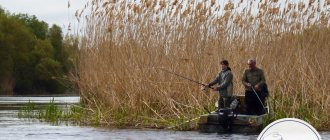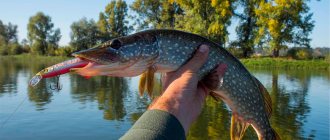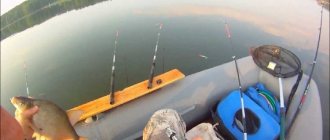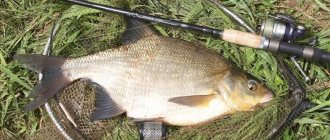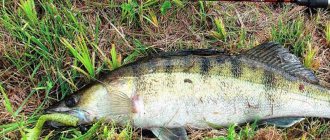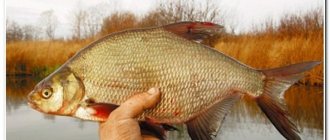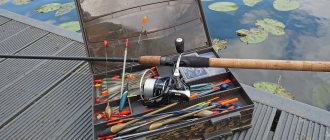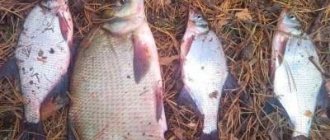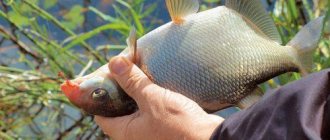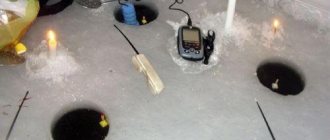02/15/2019 Gregorio Fuentes Hunting and Fishing Although bream fishing near Vizimyara, on the Volga, attracts many lovers of good fishing, some experienced fishermen have never tried to catch their catch on this famous Russian river. As experienced professionals say, if you know how to fish for bream correctly and know the good places, you can catch so much on the Volga that everyone you know will be amazed. Indeed, this is a very rich body of water. In addition, spending time on the Volga is pleasant in itself, and if the season is warm, then, in addition to fishing, you can entertain yourself with swimming and other traditional activities.
How to come with a catch?
Of course, experienced fishermen say that catching bream on the Volga from the shore or from a boat is always successful, but for a beginner it’s not so simple. You need to know how to hunt this fish correctly, only in this case the catch will delight you with its volume and become a source of pride. There are several general tips and recommendations. By following them, you will be able to catch your own fish, and even one that all your friends will envy. Some people think that catching bream is one of the most difficult tasks. You need to have specific knowledge, equipment, and also be thoroughly prepared for the process.
The first and main thing on which the success of bream fishing on the lower Volga (and in other areas of the reservoir) depends is the correct choice of fishing point. Pockets are considered to be the most successful options. You can settle in a semi-bay or choose a place where the water flows slowly and calmly. The optimal depth is about three meters with a deviation up and down by a meter. If there is a fallen tree here, this area is especially good for catching bream. It is advisable to choose areas whose bottom is clay and sand. If possible, it is necessary to clean the bottom.
Float rods
Hunting for this fish has long been popular among amateurs, and due to its widespread distribution in Russian waters, it has long become one of the most popular types of fishing. The appearance on the market of more advanced equipment and progressive equipment can significantly expand the possibilities of using float gear when fishing for these fish. Catching bream on a fishing rod with a float has become more successful and interesting, since the improvement of fishing rods and the use of more delicate, inconspicuous residues have significantly expanded the possibilities of this type of hunting. Fishing at a great distance from the shore and in strong currents using special rigs has become commonplace.
Float tackle for bream can be mounted on four types of rods.
Flywheel
It is better to choose a telescopic version without installed access rings. Preference should be given to products made of carbon fiber or carbon fiber due to their low weight. For catching bream from the shore, long forms are preferred - 5–9 meters. At the tip of the rod you need to install a connector on which the fishing line is attached. This makes it easier to quickly replace the rig if fishing conditions change.
A fly rod is very effective for bream fishing from the shore.
For fishing in still water, as well as in the middle reaches, a 30-gram test is enough.
Match fishing rods
Match forms are used for long-distance fishing from a depth of 5–7 meters. Prefabricated plug rods with a length of 3.5–4.5 meters with a slow or medium action are effective, which softens the jerks of the trophy when fishing and preserves the delicate bream lips from the rush. Test indicators for such rods usually do not exceed 15–20 grams. This allows you to comfortably make long-distance casts with light tackle,
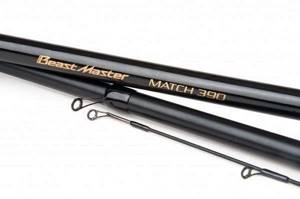
Match rods are convenient and effective when fishing for bream from the shore.
Bolognese rods
Bolognese fishing rods are used for fishing from the shore with a length of 5–7 meters, and medium-diameter rings are chosen to prevent their holes from being clogged with filamentous algae fibers and mud deposited on the cord. A test of 20–25 grams is quite sufficient for comfortable casting with any attachments and loads and the rig designs used. By analogy with fly blanks, blanks made of carbon fiber are preferable - they are lighter than others, they put less strain on the hands,
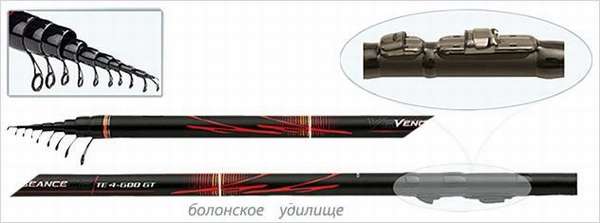
Durable and lightweight Bolognese rods are comfortable when fishing from the shore.
Plug rods
Plug rods are most often used in lengths of 9–12 meters. At the same time, feeders are installed at the ends, allowing you to comfortably fish out prize specimens. It is better to use a plug made of lightweight material - carbon fiber, which ensures their low weight. The connections at the joints are play-free, which makes it easier to dismantle and reassemble the blank when rolling back the rod.
What's next?
The process of catching bream on the Volga (middle, lower and other parts) continues by feeding fish. Complementary foods are prepared in the morning. Mix 100 g of millet and half as much rice, the same amount of buckwheat. Add 0.2 kg of pearl barley to the mixture. All components must be prepared correctly. Boil the pearl barley for about a quarter of an hour, add the remaining ingredients to the container and cook for no more than ten minutes. Remove the container from the heat and add 100 g of bran and the same amount of corn flour. The contents of the container are thoroughly mixed and evaporated for half an hour. When the porridge has completely cooled, special aromatic additives are added to it. They will make the bait interesting for the fish and activate the bite.
In order for catching bream on the Volga with a fishing rod to be successful, the bait is scattered throughout the selected area approximately half an hour before the start of the “quiet hunt”. The mixture is divided into balls with a diameter of about seven centimeters. A couple or three of these pieces are thrown into the water. After another successful bite, you need to throw another ball, this time smaller - four centimeters in diameter.
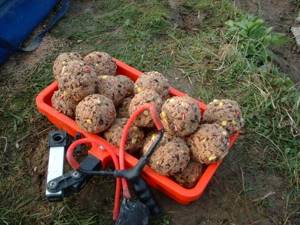
Equipment
The most successful bream-oriented fishing on the Volga is a process for which the fisherman has stocked up with suitable equipment in advance. The line should be bluish or a light shade of brown. White can be used, but is not recommended. The best diameter is 0.25. To make a leash, use a fishing line with a diameter of 0.2. Convenient and suitable hook sizes are from 8 to 12. Long and thin specimens are suitable as a float. Bird feathers, plastic and foam floats are very good. The sinker should be medium in size. You can take pellets made of dark lead - several pieces. The best leash length is up to 35 cm.
Having completed the selection of equipment, they proceed directly to fishing on the Volga aimed at bream. Besides equipment and skills, patience is important. The fish is quite careful and will not swallow the hook on its own. Maggots and bloodworms are put on the hook. Experienced fishermen advise making a complex filling, combining a worm and maggot. The worm can be replaced with a bloodworm. However, you should not use a nozzle that is too large. Large worms and crawlers are not suitable for catching bream. The sting should be open. The fisherman’s task is to place the bait beautifully, carefully. If a worm is used, there should be no long tails. If the target is a large bream, the worm will not help.
Preparing gear for fishing
When fishing for bream, you need to prepare the following components:
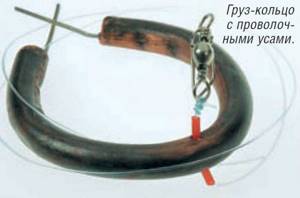
- Line with a diameter of 0.30-0.45;
- Side rod;
- Nod;
- Ring;
- Two or four hooks;
- Line with a diameter of 0.8-1.5;
- Feeder;
- Weight for the feeder.
We install the fishing line to the fishing rod and make a loop about 10-15 cm and attach the ring. Next we prepare the leashes. They can be secured with carabiners for quick changing and adding new leads. There are two types of fasteners for the leash to the fishing line: tight and sliding.
In this case, the leash is placed at 110-130 cm with a pair of hooks or more. The best solution would be hooks for bream and other carp fish. This will add convenience to bait placement and ease of removing caught fish from the mouth.
Hooks
Particular attention should be paid to hooks . They must be sharp, only then will they last a long time and prevent the fish from escaping. A well-sharpened hook should slide easily over the nail when passed with the tip.
After making all the necessary manipulations with the tackle, you can start fishing.
How to prepare a feeder for bream fishing?
Fill the bait mixture as follows:
- First you need to attach a weight so that the feeder does not float up;
- Behind the load comes the bait itself , which is laid tightly enough so that it does not fall apart ahead of time and at the same time you will have to make sure that the bait is not too compacted;
- Next, you need to carefully close and attach the feeder to the cord;
- Release the feeder to the bottom.
Preparing to install the ring for fishing
- Take the fishing line and thread it through the ring, into a special hole.
- Install the ring on a cord or thick fishing line to which a feeder with bait is attached;
- Release all the tackle into the water, make sure that the line does not twist or overlap the cord;
- The leashes should be placed a little further from the feeding area.
Do not allow the bait reel to unwind the line excessively.
Options
If a fisherman goes hunting for bream, on the Volga you can find places where there is a good chance of catching very large fish of this species. True, you need to navigate the situation when choosing bait and equipment. Experienced fishermen believe that a jig is necessary to hunt large fish. You should not use tackle with a sinker; a combination of a float and a jig is enough. The bait will be calm, that is, it will not be difficult to deceive the fish. If the day turns out to be windy, the fishing process becomes easier, since it is easier to fish. The gear described earlier is suitable for such fishing. The best fishing rod length is within 5-6 meters. You must have a 0.2 gauge fishing line, as well as a reel and float. The only difference is the replacement of the bait and sinker on the jig. When choosing a suitable one, take into account the need for a strong and very sharp hook. The best hook is high.
Experienced fishermen who have gone to the Volga for bream more than once recommend fishing with a horizontal jig. The most useful jig for the conditions under consideration is considered to be one in which the hook is placed on top. It is perfectly camouflaged in the bottom, while the nozzle remains visible. To make it easier to deceive the fish, you need to take a gray jig. A shiny specimen, on the contrary, is not suitable. If you decide to fish with a float, you need to balance it so that the bait lies on the bottom. It is equally important to take care of the presence of a landing net in advance. This is especially important if the coast is steep. The bite is indicated by the rapid rise and slow dives of the float.
Fishing is fun!
Catching bream on the Volga from a boat, from the shore, is a process that at the same time requires patience, passion, and the ability to maintain concentration on the process. Experienced fishermen advise one simple way to attract the attention of fish. It works regardless of what is used as bait. Every third or half an hour, the float is raised slightly, the hand holding the fishing rod is moved to the side, and then returned to its original position. This simple maneuver attracts the attention of the fish, making it easier to catch the coveted bream.
If you manage to catch a large specimen, you can’t waste time. You need to immediately throw bait into the water. Only after this do they remove the fish from the hook and throw in the freed tackle. If the bite is over, you should try with a different attachment. Surely this will lead to success. In summer you can fish this way from sunset until the morning. During the daytime, fishing begins at seven or eight in the morning. In autumn you can catch bream at approximately the same hours.
Other ways to catch bream
The popularity of bream fishing from the shore is a consequence of the abundance of this species. In particular, bream fishing on the Volga is the main activity of local fishing enthusiasts.
Hunting on the river involves fishing in various conditions; you can catch bream in the current only by using special fishing gear adapted for this purpose.
Bottom fishing rods
This type of gear is the most common among fishing enthusiasts and is used to catch bottom species. In current fishing conditions, they are adapted in such a way that apparent interference is used to increase the efficiency of the process.
The point of such fishing is to deliver the bait to the place where the fish are most likely to be, taking into account external conditions. And to increase the chances of success, you need to deliver the bait to the same place.
Simple donka
Installation of a donkey includes the required elements:
- main line,
- sinker-feeder of various designs,
- hooks, the design and size of which are selected depending on the type and size of the intended trophies.
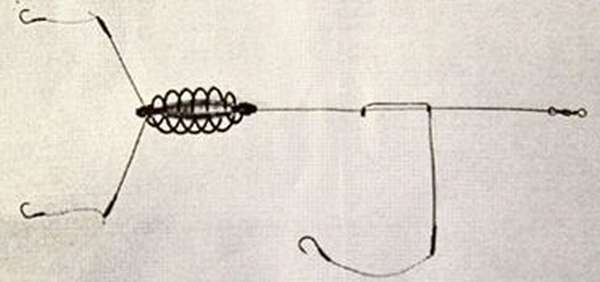
A popular method of installing a bottom fishing rod with a feeder.
The designs of individual elements can have a variety of embodiments depending on the preferences of the manufacturer.
Feeder devices
In principle, a feeder is an improved donka, for which a specially designed fishing rod has been invented. It is characterized by increased strength and bending ability. The main design difference of the feeder blank is the presence of a set of tips (the upper link of the rod is replaceable) of varying elasticity and ability to bear loads. This allows you to reconfigure the tackle depending on the fishing conditions, the required casting distance, and the weight of the feeder used.
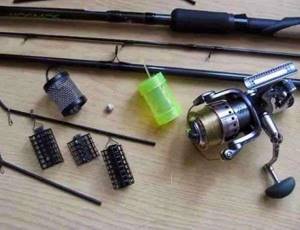
A set of accessories for effective feeder fishing.
The peculiarity of a fishing rod of this design allows you to successfully catch bream in the current at long distances from the shore. The main condition for success when fishing with a feeder is that the fisherman masters the technique of accurately casting the feeder and installing it in the same place during the fishing trip.
Using rubber bands
When fishing for bream, many anglers use rubber cords to deliver bait to the fishing spot. There are several ways to do this, for example:
- Delivery of the fishing part of the gear and the end of the rubber band to the desired place in the fishing area using a watercraft. To do this, the rod is rigidly attached to the shore, the reel is removed from the brake (or opened). The end of the rubber band is tied to the boat. When importing, it is necessary to control the rubber tension and when it reaches a small value, an end load weighing about 60–100 grams is released. In this case, the fishing line of the fishing part moves freely behind it. At its front end you need to install a weight weighing up to 40 grams so that it remains at the bottom during the fishing process.
- Upon returning to the shore, the fishing part of the gear is removed from the water and bait or bait is installed on the hooks.
- You cannot let the line go freely; when moving quickly, the leashes (up to 5 of them are installed in such gear) will inevitably get tangled around the main line; you should release the line in a controlled manner with a reel or by holding it in your fingers.
- At the end of fishing, the outermost weight is removed by the elastic band. There is always a risk that it will break.
This undesirable result can be avoided if you use the second method of installing the tackle with an elastic band. To do this, the end of the rubber cord is secured to a heavy load weighing up to 150 grams along with the front end of the catching part. Further:
- Casting is done using a powerful rod with a cast of at least 250 grams. Its range should ensure that the fishing part of the tackle is reeled out to the required length. The limiter is a previously installed clip. At the same time, the pre-wound tourniquet comes off.
- Its rear end is wound onto the reel to the desired tension.
- At the end of fishing, the anchor weight is removed by the reel.
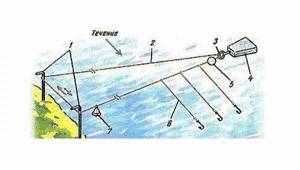
Scheme of catching tackle with an elastic band for catching bream.
In this way, you can avoid losing the elastic due to breakage, even if the anchor weight gets stuck and is lost.
Fishing for bream from the shore with a rubber band can be very effective when using feeding feeders.
Summer and fishing
According to many, catching bream on the Volga from a boat and from the shore in the summer months is perhaps the best pastime available to a modern person who is passionate about fishing. Indeed, the area is incredibly beautiful, the weather is pleasant, especially if you choose a fine day. They go out for bream when the fish spawning comes to an end. It is believed that June is the best time for summer water hunting. In addition to bream, during this period you can catch all other cyprinids. It is taken into account that during this period the diet of fish changes somewhat. The white bream will happily eat plant bait; using animal bait will be no less effective. You can go hunting for fish both during the day and at night. During the cold season, night fishing is hopeless, so many fishermen are looking forward to summer, when they can again give themselves unforgettable nights under the starry sky on the banks of the greatest river in the European part of the country. The bream zhor is especially active from the first days of June and remains intense until the middle of the next month, so the fisherman is guaranteed adrenaline.
After mid-July, the fish's interest in the bait drops sharply. A new surge is observed in the last days of August or early September. Although during this period, catching bream on the Volga with a feeder, fishing rod and other methods will give less impressive results than in the summer, the pleasure will still be great. But in June it is especially pleasant to fish, because during this period the water level drops somewhat. Bream and bream try to go to greater depths, and any pool or edge is an excellent opportunity for an experienced fisherman. When choosing a place to place gear, it is worth taking a closer look at the holes in the riverbed.
Catching bream on Akhtuba with a float rod and bottom tackle
Bream fishing can often be very exciting, especially when you consider that bream in deep-sea reservoirs if there is enough food
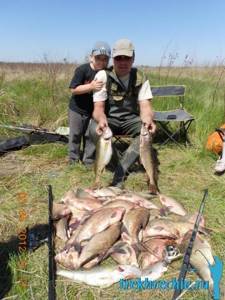
can reach a weight of 5-6 kg, and lives in large flocks. The largest bream I ever saw weighed 8.5 kg and resembled a huge bronze brazier. But he was caught by fishermen in a net on Lake Seliger near Ostashkov. On Akhtuba and Mangut in the Three Rivers region, when fishing for bream, you usually come across specimens weighing 0.7-2.0 kg and up to 40 cm in length, although cases of catching bream weighing about 5 kg are not uncommon. Together with the hazel flocks, as a rule, the bream and often the silver bream also feed.
If the fishing process is organized correctly, the fishing place is chosen correctly, the bait in composition and quantity corresponds to the whims of the fish, and the bait corresponds to the season, fishing will certainly be successful. And although even large bream are not fighters, they behave sluggishly when fishing, especially when they “sip” air, the size of the specimens and the total weight of the catch usually leave the angler delighted. In addition, although bream meat is bony, large and medium-sized specimens can be prepared very tasty by baking, smoking, adding to fish soup or simply frying in a frying pan. Medium and small specimens will delight lovers of dried fish, especially in the fall, when bream gains a fair amount of delicious transparent fat by winter. It should be noted that bream, especially large ones, can be very cautious, afraid of unnatural sounds, strange smells, and suspicious-looking bait. Therefore, you should use the thinnest, lightest, most inconspicuous tackle possible and select bait appropriate to the fishing location and season. So, how do you usually catch bream on the Lower Volga and on Akhtuba in particular? Let me start with the fact that this schooling fish loves “big water”, that is, it prefers to live in reservoirs and rivers with clean water, rich in oxygen and a medium or weak current. Bream feeds on small mollusks, worms and other invertebrates, which they dig out from the bottom at night. In summer, bream sometimes go out into the thickets of aquatic plants at midday and bite off all sorts of little things from the underwater part of the stems and the back side of water lilies. Bream love rivers with great depths (Akhtuba and Mangut are ideal for them, since the channels have holes up to 28 m deep) and with a gravel or sandy bottom. Bream avoids areas with rocky and heavily silted bottoms. Bream in Trekhrechye is caught all year round, with the exception of the spawning period, which begins after the water rises in the spring. They do not like very hot weather and at the height of summer you can catch bream at a shallow depth of up to 5 meters only at night or at dawn. The best time for catching bream in the Lower Volga is late summer and early autumn. The main thing in bream fishing is to choose the right place and, using bait, try to keep a school of fish in that place for as long as possible. The main bait for catching bream in open water is an earthworm and dungworm, but depending on the season and local preferences of this fish, bloodworms, maggots, caddis larvae, as well as vegetable baits (especially at the end of summer), such as corn, peas, can be successfully used and steamed wheat. “Sandwiches” - baits combined from plant and living components (corn + worm, grain + maggot, etc.) often give good results. In any case, you need to actively experiment at the beginning of fishing in order to understand what large bream likes at the moment.
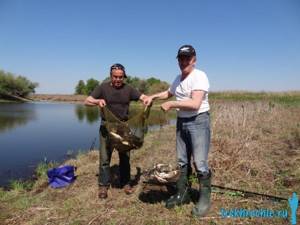
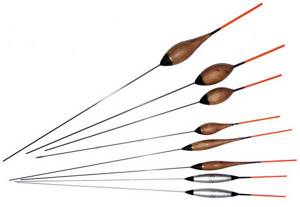
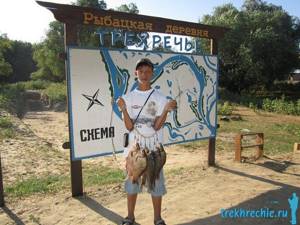
Peculiarities
Fishing for bream on the Volga at night attracts many people with its double extreme and strong impressions, which means greater pride in the catch. As experienced fishermen know, in the dark, the desired fish goes to relatively shallow areas of the riverbed, where it tries to find food. This is where it makes sense to catch bream when the darkness of night has fallen. The place is chosen while the sun still illuminates the river. The deeper the area, the greater the likelihood that the desired prey will emerge only towards the end of daylight. If there is no opportunity to go night fishing at all, the only option for a summer fisherman interested in bream is to find a suitable hole.
In the summer, catching bream on the Volga with a donk, with a simple fishing rod, will be successful. You can fish using a fishing rod with a special shock absorber. You can select a posting instance. You can catch bream using a feeder, fly rod, or match tackle. You can catch it with a ring. In a word, any option is good and promising, so the fisherman can choose what he likes best, what he is used to.
Fisherman's Club
I started catching bream in 1975 in the Middle Volga in the Samara region above and below the dam of the Zhigulevskaya hydroelectric station.
For the last 15 years I have kept records of fishing trips, indicating when, where, with what gear, what kind of fish and in what quantity I caught. What were the weather conditions, water level in the Volga, pressure, wind, etc. Over the years, a certain amount of experience has been accumulated, and I will be sincerely glad if this note helps any of my hobby colleagues, especially beginners, to increase their catches of bream, one of the most numerous fish in our waters.
I started catching bream in 1975 in the Middle Volga in the Samara region above and below the dam of the Zhigulevskaya hydroelectric station. For the last 15 years I have kept records of fishing trips, indicating when, where, with what gear, what kind of fish and in what quantity I caught.
What were the weather conditions, water level in the Volga, pressure, wind, etc. Over the years, a certain amount of experience has been accumulated, and I will be sincerely glad if this note helps any of my hobby colleagues, especially beginners, to increase their catches of bream, one of the most numerous fish in our waters.
I understand perfectly well that recommendations for fishing in one area, which are purely subjective, may turn out to be unacceptable and even harmful in other conditions. But I believe that the transfer of experience is always positive, since it broadens the horizons of fishermen and encourages them to search for independent solutions, to experiment, which is sometimes the path to success.
Below the dam near the city of Syzran, my friend and I started fishing after purchasing a Progress boat with a Whirlwind-30 motor. At night we caught bream at a depth of 4-5 meters, and during the day at a depth of 12-16 meters, almost next to the fairway.
The Volga in these places is quite narrow and the current is strong on weekdays. The side fishing rods had a main line of 0.5 mm with a powerful sinker and a five-meter leash made of 0.4 line with five hooks No. 7-8 according to domestic numbering tied every meter. The bait was dung and earthworms, and maggots.
Only rye bread was used as bait at a price of 16 kopecks. For fishing, we bought 6 loaves for each person.
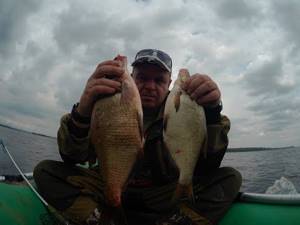
They broke the bread into pieces, filled a bag with a large load with them, and lowered them to the bottom on a millimeter fishing line. They caught it with a ring.
Using a 0.15 mm fishing line, the sinker of the fishing rod was tied through the hole to the bait line and the tackle was lowered onto the bag. When hooking, the thin line broke.
During the current, the bites were sharp, the fish were reliably caught. In addition to bream and white bream, there were chubs weighing up to 2 kg, as well as pike perch and medium-sized catfish.
At night, the fishing rods were loaded with a lighter weight and a 0.3 mm fishing line with a 30 cm leader and 1 hook. The same bread served as bait.
On a calm night, we anchored at 4 meters, in a slightly deeper wave. Despite all the primitivism of the gear and bait, the fishing was good.
Now everything has changed.
Groundbait and flavors
The basis of successful fishing for white fish is bait. It depends on whether the fish will suit your fishing rods or not.
I use pig feed as bait, that is, feed intended for feeding pigs. When buying feed on the market, you need to find out what ground grains it consists of.
Ground wheat and oats, either pure or in any proportion, are ideal for fishing. Barley makes the bait crumbly and it is better to do without it.
Ground peas lead to faster souring of the bait in hot weather. Chicken feed is unacceptable, since it may contain ground pearl barley and other shellfish, and soon after cooking it already has a bad odor.
I prepare the bait as follows. I fill the bucket 3/4 full with water, throw 10-12 potatoes cut in half, 0.5 kg of millet, wheat, or pearl barley into the water, add 10-12 garlic cloves, peeled and cut into 3 pieces.
I put the bucket on gas and boil for about 30 minutes, then add feed to the boiling water, stirring, until it reaches the consistency of thick porridge. I turn off the gas, cover the bucket with old clothes and let it sit for a couple of hours.
Properly prepared bait should be sticky and easy to mold into balls. If the feed contains barley, then for stickiness it is necessary to add flour, or semolina, or ground crackers to the bait.
These components are added while stirring over the fire.
Rules and risks
When planning to catch bream on the Volga using a donk, feeder, ring or any other gear, you need to familiarize yourself with the rules. In the dark this river is navigable. In our country, it is strictly forbidden to be on the water in a simple boat in the dark if industrial vessels can sail along the riverbed. Accordingly, in the summer season at night it will not be possible to fish from a boat using a ring or a fly-wheel tool. You will have to adhere to the restrictions - they are designed for a reason. If a collision suddenly occurs, the fisherman in a recreational boat is likely to suffer, and the consequences can be severe.
When planning a fishing trip, you need to take into account the fish’s tendency to move. As stated earlier, during the day the bream hides in a deep, dark place, and at night it moves to shallow water, trying to find food. The morning period is the moment of fish migration. During this period of the day, it is better to choose slopes and edges for water hunting. During the daytime, it is recommended to fish using a boat and all the tools that are relevant for this option.
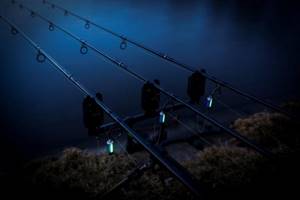
Safety
Fishing from a boat requires a lot of attention from the angler. It is necessary to follow safety rules when operating watercraft, monitor the boat so that it is in good condition, and be sure to use life jackets when fishing! It is also necessary to monitor restrictions on the operation of boats related to fish spawning, follow the rules regarding boat motors, and always have documents for the boat and motor with you in a waterproof bag.
You can ask your question to our author:
Nuances of nutrition
In order for catching bream on the Volga with a ring, feeder, donka and any other type of gear to be effective, it makes sense to take a closer look at the possibilities of using various complementary foods. As stated earlier, during the warm season the feeding pattern of fish changes, and this affects the choice of complementary foods. If in the cold season the best aromatic additives are spicy, then in the warm season it is better to take fruit and sweet scents. According to experienced fishermen, preference should be given to caramel, cinnamon, cherry aromas, vanilla and strawberry additives and those that smell of honey. No less effective are mixtures prepared with the inclusion of fresh anise and dill. It is known that in some places fish bite best on anise and dill, but in other parts of the Volga aquatic inhabitants completely ignore this bait option. To understand how things are in a particular case, you need to experiment.
The composition of complementary foods is no less important. You can take a ready-made store product, or you can make it yourself. According to many fishermen, it is better to cook “Salapin” porridge. It is distinguished by the balance of ingredients, good in both mechanical qualities and taste. Bloodworms and maggots are appropriate baits. In the summer, you can use peas and dough. An equally successful result will be when fishing with corn, pearl barley and semolina, and pasta. You can boil potatoes, steam wheat, or use bread made from wheat flour. Bream is quite cautious, so it is not easy to please it, and a good result is achieved by combining several products at once. You can put a corn grain on the hook, then a star (pasta). This form is convenient due to the presence of a hole, but you can use any other product. The structure is fixed with a pair of maggots. The quantity is changed based on the characteristics of the case and the size of the fish. Well, if you don’t want to prepare such a complex structure, you can simply fish using a combination of maggots and worms.

When the cold is no problem
Fishing for bream on the Volga in winter is no less attractive in summer. At this time of year you can also use different gear. According to experienced fishermen, the devil is the best and most reliable option. This is a fairly simple method of water hunting; even those who are new to winter fishing can quickly master it. If you set up the little devil correctly, you will be pleased with the frequency of bites. The bait is a tee made from a teardrop-shaped base. No less important than bait is wiring. The devil is more suitable for winter than a jig. You can make a system with a hanging hook or a “jellyfish”, you can make a soldered tee or hang movable hooks. On average, the length of the bait is about one and a half centimeters. Weight – at least gram.
There is no doubt about the success of the event, because the coveted fish does not hibernate during the cold season. Bream is found not only in the Volga, but also in many other reservoirs. In the cold, the fish weakens, it is somewhat more sluggish, and relatively inactive. For this reason, bream does not react so actively to the bait, which means it tests the fisherman’s patience. As experienced specialists note, this only makes the process even more interesting, exciting, and exciting. True, you need to remember the basic rules. Of course, winter fishing is interesting, but safety comes first. They go fishing only in the dead of winter, when the ice is very thick and the oxygen concentration in the water decreases. In the temperate climate zone, this period begins approximately in the middle of the first month of the year and lasts until the beginning of spring. According to fishermen, this time is most suitable for fishing.
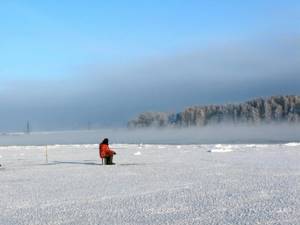
Nature and weather
During deep winter, the climate greatly adjusts the life activity of the inhabitants of reservoirs. In winter, bream fishing on the Volga is completely subject to these natural processes. The fish reacts relatively weakly to the bait; feeding does not give the desired result. The colder the weather, the deeper the fish go. Bream gradually migrates to maximum depth, and it is simply impossible to catch anything near the shore. If a certain area is characterized by an abundance of bottom vegetation, if a lot of grass grows here, you should not even try - there will be no success. If the ice layer has just appeared, if it is thin, you can catch fish in areas up to four meters deep. In the middle of nowhere, however, you can’t find anyone in these areas - the fish go deeper. Mostly the level is five meters or more. Bream prefer to stay in bottom holes and uneven areas during the cold season.
Fishermen experienced in winter bream fishing on the Volga say that it is easier to find fish where streams or other rivers flow into the great river. If there is a bottom spring in a certain area, it is worth trying to fish there. The more actively the water moves, the more oxygen it contains, which is vital for bream to survive.
About habits
You need to know about the habits of fish. If the frost is very strong, the bream moves to a depth of up to 12 meters. Such areas are located at the edge of a cliff, in a bay or on the edge of a hole. This is where it makes sense to search and catch fish. If the hole is filled with snags, the bream will not swim into it. The fish prefers a bottom made of clay and sand. If you plan to travel to a new area, whose characteristics are still unknown, it is worth talking to the locals. Fishermen will probably tell you where it is best to make a hole. Without knowing the features of the bottom landscape, one cannot count on success.
Technique for catching bream with a ring
The ring is fished exclusively from a boat, at a depth of at least 5 meters, so as not to frighten potential prey with a huge spot hanging from above (the silhouette of that same boat).
After installing the watercraft on the anchor (preferably across the current), the filled feeder is lowered to the bottom and the cord is pulled. Next, you need to put a ring with leashes and baited hooks on it through the cut and carefully lower the equipment down until it touches the feeder. As a result, the ring will lie on top of the feeder, the current will pull out the leashes, and the hooks will end up on the feed path. After some time, a bream or other fish will stumble upon a tasty trail and follow it to a hook with a nozzle. After the bite, you need to hook and lift the equipment back in the same way.
Lifestyle and weather
Bream fishing on the Volga in February, during the deep winter period, is organized taking into account some of the characteristics of this fish. For example, it has long been known that it belongs to the group of schooling fish; the dimensions of each fish are quite large. As a result, the most suitable areas for habitat are large-scale zones where there is enough space for all members of the flock. For a fisherman, this means that he cannot count on large catches with just one hole at his disposal. In addition, as experienced people believe, it is unwise to stay at one hole in the ice all the time, since a person makes noise and his presence leads to the penetration of light into the water column. This scares the fish and makes the bite worse. If you don’t want to wander between holes, you need to use complementary foods. It is necessary to throw supplements generously, plentifully, regularly. This is the only way the fish will begin to gather at the hole.
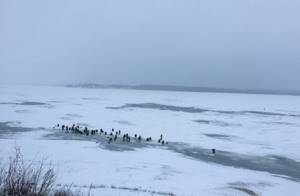
For the winter season, it is very important to follow the rules of complementary feeding. If you prepare it correctly, you can count on a good catch the very next day after throwing out the food. However, it is worth mentally preparing for the fact that you will first have to feed the fish for several days, only after that some kind of reaction will appear. The larger the bream, the later it notices food. The larger the fish, the less likely it is to start biting. The fisherman must understand that the fish’s interest in food is also related to its size. Bream under a kilogram will eat almost anything, but large fish are picky. To catch a large specimen, you will have to stock up on delicate equipment. The best food for bream is protein. This means that the bait must contain animal products. Bloodworms are used as a base, breading, sunflower cake, and semolina are added. Plant products form a nutrient cloud near the animal ingredient, and this awakens the interest of the desired fish.
Source: fb.ru
Fishing for carp
Carp is a strong and lively fish. Therefore, there are special requirements for equipment. Everything must be very reliable. Powerful number eight or nine hook. Attached with a leash to the main fishing line. Capable of holding the jerks of this fish weighing ten kilograms. You can also use braided fishing line. But it’s still better to make a leash from monofilament.
During currents you will need an anti-twist agent. This is a plastic tube to which the sinker is attached. It reduces the likelihood of the leash and the attachment getting tangled in the main line. At the moment of casting. The load is selected depending on the speed of the current and the casting distance. Usually 40 - 60 grams is enough. For fishing, use a classic bait - a bunch of worms.
